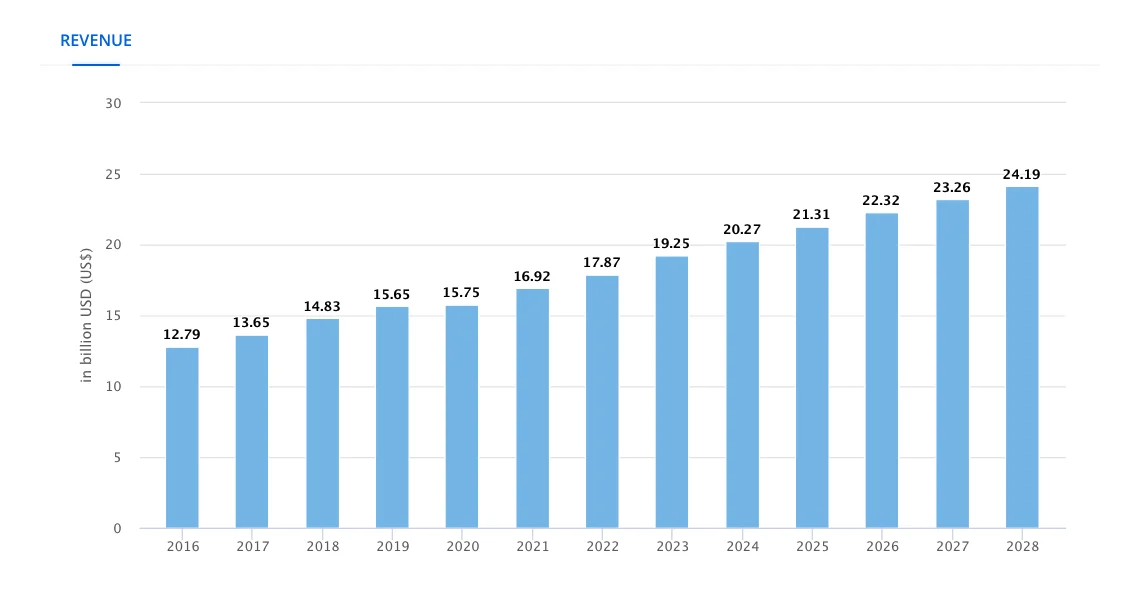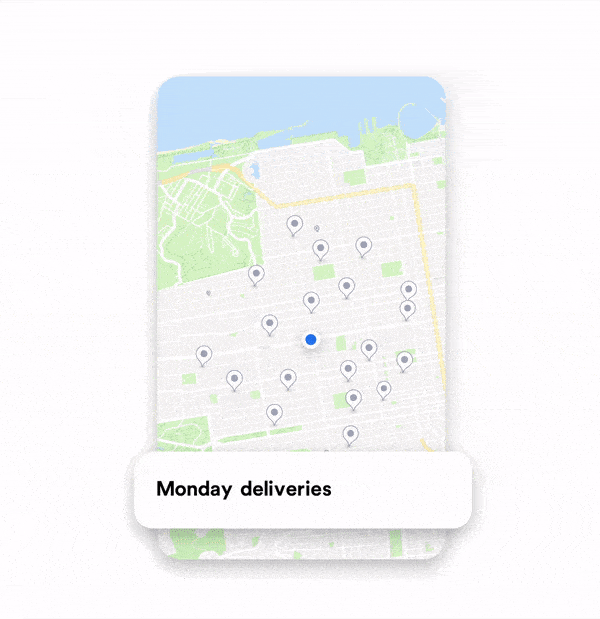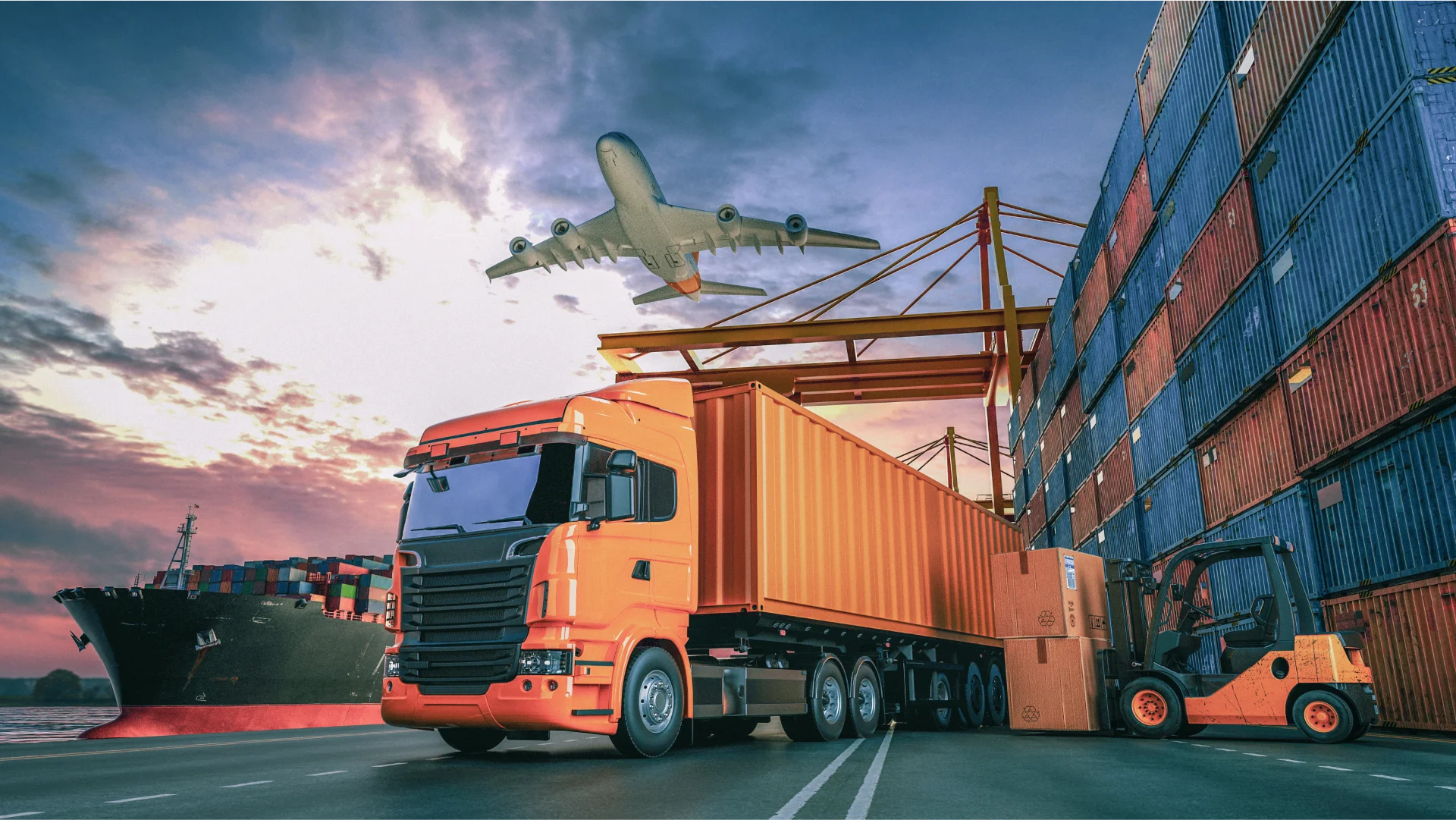Key Features Every Logistics App Should Have
- Mobile
- March 16, 2023
The logistics industry serves as the backbone of global trade and a vital pillar of the global economy. In recent years, this sector has undergone a profound technology-driven transformation to the point where we now recognize it as one of the most dynamic and progressive segments of the economy.
The logistics industry worldwide is expected to exceed 13.7 billion euros by 2027 which includes all B2B, B2C, or C2C supply chain networks. These stats pose a bright opportunity for industry stakeholders to innovate and add more to their business revenue, with logistics app development being one of the most lucrative digital solutions.
Further, according to Statista’s market insights on supply chain management software, revenue is expected to show an annual growth rate (CAGR 2023-2028) of 4.67%, resulting in a market volume of US$24.19bn by 2028.

This is how the logistics business owners can know that their service is in demand and their decision of logistics software development would only add to the rapid growth of their business.
Before we jump into the essentials of a logistic app, let us first understand some more reasons why business owners or entrepreneurs seeking their next venture in the logistics industry must consider logistics application development.
Why Develop a Logistics App?
There are various facets in which a company may benefit from developing a logistics app. This includes:
- Monitoring the location of the vehicle via GPS feature.
- Fleet management by real-time insights into the fleet’s operations.
- Parcel or Cargo Booking for customers, via solutions similar to those used by FedEx.
- Cargo tracking via NFC and RFID technologies.
- Warehouse management, including inventory management, dispatch information, and data tracking.
Therefore, to streamline the various processes within a logistics company as well as to ensure transparency with customers, businesses are moving towards using apps that cater to their various needs.
Features and functionality make a logistics app for that matter a success as that is what the users(business owners/admins, dispatchers/drivers, end users/customers) seek when using the logistics app. Here are some of the must-have features to consider when developing a logistics application.
The Key Features of Logistics App
It’s the features and functionalities that enable the logistics app to stand out among the competitors along with providing all the stakeholders(divers/dispatchers, users, and admins) access to the information critical to them. Here are some of the critical features of a logistics app:
User App Panel Features
Order management
From the order, tracking, and monitoring to canceling or reordering the shipment and order history, order management enables the users to have insights into every aspect related to their shipments.
Search nearby vehicles
Facilitates users to select the available vehicles in the vicinity for transportation to ease logistics coordination and increase convenience. For business owners, it enables robust resource allocation and efficient logistic operation.
Choose vehicle
This feature of the logistic app enables the user to choose the best-fit vehicle(van, truck, or specialized carrier) for their shipment according to the consignment size(small parcel, bulk order, or special cargo) and more.
Tracking
Users can conveniently monitor the status and location of their packages at every stage of the delivery process, helping them plan and prepare for their deliveries.
Real-time alerts and notifications
It provides real-time updates of shipment delivery at every stage(in transit, order processing, staging, loading, out for delivery, etc.). Further, the logistics company can also send notifications of offers, discounts, coupons, and more.
Multiple payment options
Allow the users to choose their preferred mode of payment(credit/debit cards, UPI, mobile wallets, cash on delivery or more).
Ratings and reviews
It would enable the users to provide ratings and reviews for the services, which would help other users(regarding the quality of services) and logistic companies(regarding improving the logistic app, or any service aspect).
Driver/Dispatcher Panel Features
Dashboard
It offers real-time insights and information on all logistic operations in a single screen, whether it be the delivery status, delivery schedules, delivery routes, vehicle performance metrics, maintenance and repairing status, reviews/ratings, and more, along with real-time analytics, charts, and graphs.
Profile management
The driver can add/update their basic information(name, contact info, address, availability status), upload all documents(educational certificates, driving licenses, health reports, and more), and maintain an up-to-date personal profile using this feature.
Consignment/shipment delivery details
This feature provides the drivers with various consignment/shipment delivery-related information like package specifics(weight or special delivery requirements), freight details, route details, time duration required to reach the delivery destination, and more.
Nearby facilities(mechanical support and fuel stations)
Keep your drivers from getting stuck finding essential services(garages and mechanics, warehouses, fuel stations, or any other assistance centers) when on the route to delivering the shipments by just searching it in the logistics app.
Pre-planned and best route
Dynamic selection of delivery route drivers can result in time and fuel consumption increases. Adding these features in custom logistics app development in the driver’s panel would enable them to view the pre-planned route defined by the admins or business owners.

The best route feature enables the drivers to optimize the delivery route by considering factors like real-time traffic data, weather conditions, road closures, and more to minimize delays along with increasing fuel efficiency and reducing the delivery time.
Real-time GPS tracking
Apart from providing the drivers with the best route, geolocation functionality would provide the drivers with the added functionality of tracking the fleet’s live locations and getting accurate delivery estimates.
Data analytics
Being one of the most crucial features of logistics apps like FedEx or DHL, data analytics would provide drivers or dispatchers insights into various metrics such as route optimization, delivery times, traffic patterns, vehicle performance, resource utilization, and more.
Admin Panel Features
Dashboard
The admin dashboard is their eyes and ears on the ground. It provides them with a comprehensive overview of the logistics operations like pending shipments, completed shipments, ongoing deliveries, driver’s info, fleet performance, order processing status, and more.
The dashboard also provides the admins with a consolidated view of the vital data information of visualizations(charts, graphs, etc.) for efficient monitoring.
Vehicle management and maintenance
It is the fleet that facilitates the functioning of the logistics industry, which is the reason why admins have to keep an eye on fleet management and maintenance to reduce the risk of unexpected breakdowns to avoid losses or delays in service.
This feature would enable the admins to view the vehicle’s performance and maintenance history, plan for timely inspections, get maintenance alerts and schedules, and more to enhance the overall operational efficiency of the vehicles.
Manage fuel & vehicle consumption
Fuel is one aspect of logistics where the business owners try to cut the cost as much as possible, which is possible when the admins have access to various fuel consumption and vehicle utilization information like monitoring fuel levels, tracking consumption patterns, and ensuring efficient utilization of vehicles.
Driver management
From the availability of drivers to their statuses, from “en route” to “completed, the admins can have a bird’s-eye view. This logistics app feature in the admin panel would enable the business runners or admins to know the shipment/vehicle/driver’s current locations, availability, any ongoing assignments, analyze performance metrics, and more.
Transaction management
Apart from record keeping this feature would enable to verify, monitor, track, and analyze financial transactions seamlessly.
Reports and analytics
The detailed reports will provide the administrator’s insights into key metrics like inventory turnover ratio, truck turnaround time, average transportation cost, operating ratio, and more.
Apart from it, analytics features would enable the admins to get silos of logistics data into visual representations(graphs, charts, etc.), making it easier for administrators to identify trends/patterns and make informed decisions.
Further, by integrating AI in supply chain management aspects, these reports and analytics become even more powerful. You can benefit from predictive analytics for demand forecasting, route and delivery time optimization, stock health and inventory turnover, and more.
Trip log reports
Provide the admins with detailed and organized reports of each trip undertaken which includes information like route details, timestamps, and more.
Advanced Features
Multilingual support
Multilingual functionality addresses the diverse and global nature of logistics operations, ensuring seamless communication and accessibility for users regardless of their language constraints. It also enhances the user experience by offering the user freedom to use the app in their preferred language.
Offline support
Not all delivery routes would have a great network connection, this feature would ensure seamless operations even in areas with limited or no internet connectivity. It also enables users to update and sync data effortlessly when the connection is restored.
In-app chat and call
The in-app chat enables instant messaging for quick updates, instantaneous clarifications, or real-time information exchange. Whereas, the in-app call feature facilitates direct communication, eliminating the need for external calls or third-party messaging services.
For example, with the ability to initiate real-time conversations and calls, users gain a direct line of communication with drivers, ensuring efficient coordination and timely updates on their shipments.
ePOD(electronic proof of delivery)
With ePOD, users can seamlessly track and confirm the successful receipt of their shipments in real-time. The feature includes specifications such as digital signatures, timestamped delivery confirmations, and geolocation tagging, providing users with a reliable means to validate and document the delivery process.
Driver Safety
From real-time monitoring of driver behavior to fatigue detection, weather alerts, and integrating cutting-edge technologies that provide users with a heightened sense of security, the driver safety feature goes beyond the conventional for prioritizing the well-being of drivers.
Cloud Storage
With cloud storage, users(drivers, admins, and end users alike) can securely store and retrieve critical information such as shipment details, invoices, and documentation from anywhere, facilitating data security and reliability apart from real-time collaboration.

Build a Bespoke Logistics App with MindInventory
With a proven track record of delivering innovative and efficient solutions, we stand as your reliable technology partner in shaping your future. We pride ourselves on our ability to transform ideas into robust, user-friendly applications that elevate operational efficiency. Our belief in staying at the forefront of technology trends enables us to guarantee that your logistics app is not only robust and scalable but also equipped with the latest features and tech.
A dedicated team of skilled app developers at MindInventory is committed to understanding your unique requirements and translating them into tailored, high-performance logistics applications.
Elevate your logistics business with our expertise, and let us build a cutting-edge app that not only meets but exceeds your expectations. Contact our team right away to get a consultation on logistics app development ideas.
FAQs About Logistics App Development
The future of logistics app development looks promising as the global logistics market is expected to be worth $18.23 trillion by 2030. You can find more AI-induced logistics apps in the future.
The cost to develop a logistics app mostly depends on your requirements like technology stack, backend, and frontend development, app platform, location of the company, etc. To know the accurate cost of developing your custom logistics app development, contact our team.













